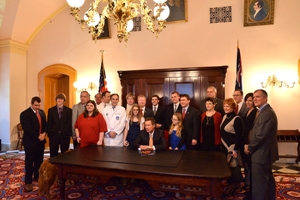Forty-nine states and the District of Columbia have enacted strong youth sports concussion safety laws since May 2009, all modeled on Washington State's groundbreaking Zackery Lystedt Law:
- Alabama;
- Alaska;
- Arizona;
- Arkansas
- California (on July 21, 2014, the state's law was amended to mandate completion of a graduated return-to-play protocol of no less than seven days, and, in response to growing concern about the long-term of repetitive head impacts, limit to two 90-minute full-contact practices in football per week during the pre-season and regular season, and banning off-season practices altogether )
- Colorado;
- Connecticut;
- Delaware;
- Florida;
- Georgia**;
- Hawaii;
- Idaho;
- Illinois (a bill limiting full-contact practices during the season to once a week was introduced but later died in the state legislature);*
- Indiana (bill proposing to expand coverage of Lystedt law to all youth sports sent for further study by legislature);
- Iowa;
- Kansas;
- Kentucky;
- Louisiana;
- Maine;
- Maryland (legislature adjourned 2013 session without acting on bill - later withdrawn - that would have required protective head gear in girls' lacrosse, and a measure to limit and regulate the amount of contact allowed in high-impact school sports) ;
- Massachusetts;
- Michigan;
- Minnesota;
- Mississippi;
- Missouri;
- Montana;
- Nebraska;
- New Hampshire (effective July 15, 2013, the state expanded coverage to intramural sports and from grades 9 to 12 to grades 4 through 12);
- New Jersey;
- New Mexico;
- New York;
- Nevada;
- North Carolina;

- North Dakota;
- Ohio (see photograph of signing ceremony at right);
- Oklahoma;
- Oregon (On June 14, 2013, the governor signed into law SB 721 (dubbed "Jenna's Law") expanding coverage of the original concussion safety law (dubbed "Max's law") by requiring parents and student-athletes aged 12 and older to sign concussion information sheet as condition of participation and beyond schools).
- Pennsylvania;
- Rhode Island (a proposed amendment to the state's law would broaden the scope of those medical professionals who can diagnose and manage a student-athlete's concussion; have all student-athletes undergo baseline neurocognitive tests prior to the start of every sport season; and require coaches/volunteers to complete an annual refresher course);
- South Carolina;
- South Dakota;
- Tennessee
- Texas;
- Utah;
- Vermont (amendment was recently enacted into law requiring school athletic coaches and referees to receive training on how to prevent concussions; prohibit a coach or an AT from allowing an athlete to continue playing if the trainer knows or should know that the athlete has sustained a concussion; require that a health care provider be consulted if a coach and an AT do not agree on whether an athlete has sustained a concussion; and require the home team to ensure that a licensed AT or health care provider is present at any athletic event involving a contact sport);
- Virginia (on March 27, 2014, Governor Terry McAuliffe signed into law a bill requiring the Commonwealth's Board of Education to include in its policies a "Return to Learn Protocol" requiring school personnel (a) to be alert to cognitive and academic difficulties that may be experienced by a student-athlete after concussion, and (b) to accomodate the gradual return to full participation in academic activities by a concussed student-athlete as appropriate based on recommendations of the athlete's health care provider as to the appropriate time that such student-athlete needs to be away from the classroom; just ten days later, on April 7, 2014, Governor McAuliffe signed into law a bill amending the Commonwealth's concussion safety law to expand coverage to include non-interscholastic youth sports programs utilizing public school property.)
- Washington;
- West Virginia; and
- Wisconsin.
One state (Wyoming) has enacted a weak sports concussion safety law that does not the requirement of the model Zackery Lystedt law in that parents and guardians are not required them to sign a concussion information form as a condition of participation.
For statistics about concussions in high school sports, click here.
For myths about concussions, click here.
* The Illinois law differs slightly from the model Lystedt Law in its approach: the law directs the Illinois High School Association to set guidelines on concussion management which parallel the three key provisions of the Lystedt Law. As a result, some websites, including MomsTEAM, count Illinois; some others don't. The fact that the IHSA does not mandate guidelines is the subject of a class action lawsuit filed against the IHSA.
** The new Georgia goes one step further than most state laws by extending the Lystedt requirements to private schools, charter schools, and youth sports outside of school. The same is true of the new Tennessee and Montana laws.
*** Some websites count Wyoming and Arkansas in their totals, bringing the total to all 50 states and the District of Columbia.
Sources: Numerous, including the Law Atlas (an absolutely outstanding, searchable data base containing all the state laws); National Coalition on Youth Sport Concussion, Safe Kids USA, NFL Health and Safety and the National Athletic Trainers' Association and the Network for Public Law (citations to, and excellent summary, of each individual state law), and Education Week; and American Academy of Physical Medicine and Rehabilitation (which has an excellent pdf tracking legislative developments).
Most recently updated April 3, 2015









